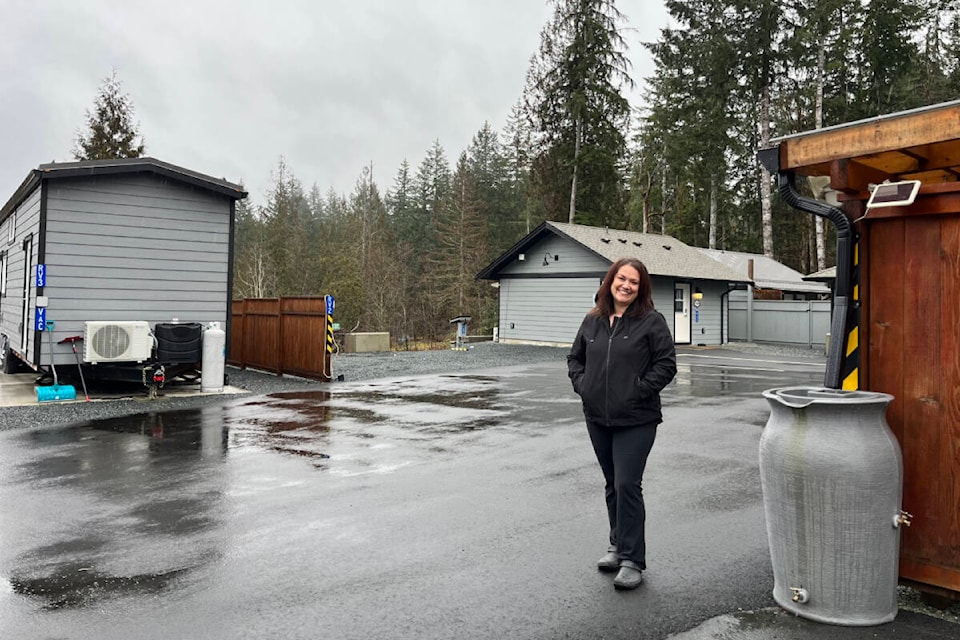Naomi Nicholson walks around the property at Chims Guest House, pointing out the different types of accommodation she and her husband Ed have spent the past two post-COVID-19 years building up. The tidy buildings—a mix of private suites, tiny homes and an RV pad, are situated off Highway 4 west of Port Alberni, and offer views of Mount Arrowsmith and the forest at the back of the property.
It’s quiet on the lot—too quiet for Nicholson. “Before the road closures and fire we were doing pretty well,” she says. “Now everything has kind of stopped, but I still have bills to pay.”
Nicholson is just one of dozens of business owners and operators impacted by the closure of Highway 4 during the Cameron Bluffs wildfire, and continuing into the scheduled weekday closures for rock scaling and cleanup.
Cancellations that came in when Highway 4 closed on June 6 due to the wildfire have had a detrimental snowball effect.
Nicholson said she has corporate bookings for companies waiting to work on large projects in the Alberni Valley, but they keep pushing back their bookings because they cannot get their oversized equipment into the city to start work.
The oversize restrictions on Highway 4 have also affected her directly: Nicholson has another tiny home that was supposed to be delivered in mid-June to her property, but movers can’t get it here: it can’t travel over the long detour on a gravel logging road, and oversize loads aren’t permitted around Cameron Lake. In the meantime she has had to start making payments on the home—without the ability to make revenue from it.
“Now I’m paying on an asset I own and can’t access and I can’t make money on it,” she said.
“We’re booked for the August long weekend for two weddings and a baseball tournament. I sure hope they still happen.”
A business impact survey conducted jointly by chambers of commerce in Port Alberni, Tofino and Ucluelet collected data on how the closure impacted businesses—not just tourism businesses.
Jolleen Dick, CEO of the Alberni Valley Chamber of Commerce and Visitor Centre, wouldn’t share an exact dollar figure but said the impact is “definitely way over a million dollars.” She had 55 Alberni Valley-based businesses respond to the survey “which is a 10 percent sample of the number of business licences we have here. Most respondents indicated 60 to 80 percent loss in their businesses as a result of the closure,” she said.
“Other impacts were having to lay off staff as a result of the (June) closure because there wasn’t enough business. Freight was a huge issue and continues to be an issue.”
The problem with the new scheduled closures, she added, is the roadwork needs to be done while the weather is good. “It’s definitely going to be a challenge.”
In Tofino, the revenue reportedly lost by businesses during the closure period was an estimated $29.7 million, according to the Tofino-Long Beach Chamber of Commerce. In Ucluelet that figure is $14 million, for a west coast total of nearly $44 million in losses.
Most of the businesses—like Nicholson—were not eligible for business interruption insurance or government assistance. Some workers were able to access EI, but many that are temporary or seasonal staff did not qualify.
For Elliot Drew, operations manager at McLean Mill National Historic Site, news of the scheduled July and August closures is disappointing. Drew was hoping 2023 would be a rebuilding year for the mill—the first since 2019 operating without restrictions.
At the beginning of the tourist season it looked like the mill was well on its way. “In the first week of June we saw 176 visitors—in literally the first five days of June,” he said.
On June 6, Highway 4 was closed when the Cameron Bluffs wildfire reached the highway. A detour route via Bamfield Main through Lake Cowichan was opened within 24 hours, but drivers were encouraged to use the detour route for essential travel only. It was a dusty, arduous road for some tourists.
Since that point, with the exception of the Saturday of high school prom—when the mill site was busy with graduates coming for photos—“we’re seeing 10 or so people per day,” Drew said.
“Although it’s increasing slowly we’re not back to seeing 30 to 40 people per day.”
While more local residents are visiting the site and using it as a place to walk, they aren’t the ones spending money in the gift shop, he said. “It makes a big difference in that revenue.”
Rock-scaling crews made “good progress” in the first three days of the new work, according to the Ministry of Transportation and Infrastructure. On Friday, July 21 they began removing one of four cranes that were put in place at the end of June to hold up a mesh fence against the bluff.
Given its complex nature, rock scaling “must be completed during good weather and during daytime hours,” the ministry noted. The work is required before the highway can be safely reopened to two-way traffic.
The road continues to be closed for two periods daily, from 9–11:30 a.m. and again from 1:30–5 p.m. There are no closures overnight or on weekends, including on the B.C. Day long weekend. Weather—particularly windy conditions—can affect closures. For up-to-date information about road conditions, go online to http://www.drivebc.ca/.
